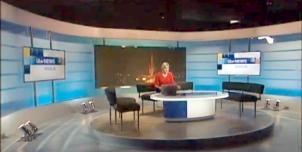Full Freeview on the Sandy Heath (Central Bedfordshire, England) transmitter
| Google Streetview | Google map | Bing map | Google Earth | 52.130,-0.242 or 52°7'47"N 0°14'33"W | SG19 2NH |
The symbol shows the location of the Sandy Heath (Central Bedfordshire, England) transmitter which serves 920,000 homes. The bright green areas shown where the signal from this transmitter is strong, dark green areas are poorer signals. Those parts shown in yellow may have interference on the same frequency from other masts.
_______
Digital television services are broadcast on a multiplexes (or Mux) where many stations occupy a single broadcast frequency, as shown below.
64QAM 8K 3/4 27.1Mb/s DVB-T MPEG2
H/V: aerial position (horizontal or vertical)
Which Freeview channels does the Sandy Heath transmitter broadcast?
If you have any kind of Freeview fault, follow this Freeview reset procedure first.Digital television services are broadcast on a multiplexes (or Mux) where many stations occupy a single broadcast frequency, as shown below.
64QAM 8K 3/4 27.1Mb/s DVB-T MPEG2
H/V: aerial position (horizontal or vertical)
Which BBC and ITV regional news can I watch from the Sandy Heath transmitter?

BBC Look East (West) 1.0m homes 3.7%
from Cambridge CB4 0WZ, 29km east-northeast (65°)
to BBC Cambridge region - 4 masts.
70% of BBC East (East) and BBC East (West) is shared output

ITV Anglia News 1.0m homes 3.7%
from Norwich NR1 3JG, 119km east-northeast (60°)
to ITV Anglia (West) region - 5 masts.
All of lunch, weekend and 80% evening news is shared with Anglia (East)
How will the Sandy Heath (Central Bedfordshire, England) transmission frequencies change over time?
| 1965-80s | 1984-97 | 1997-98 | 1998-2011 | 2011-13 | 12 Feb 2020 | ||||
| VHF | A K T | K T | K T | W T | W T | ||||
| C6 | ITVwaves | ||||||||
| C21 | C4waves | C4waves | C4waves | +BBCB | BBCB | ||||
| C24 | ITVwaves | ITVwaves | ITVwaves | D3+4 | D3+4 | ||||
| C27 | BBC2waves | BBC2waves | BBC2waves | BBCA | BBCA | ||||
| C31 | BBC1waves | BBC1waves | BBC1waves | ||||||
| C32 | com7 | ||||||||
| C33 | SDN | ||||||||
| C34 | com8 | ||||||||
| C35 | _local | ||||||||
| C36 | ArqA | ||||||||
| C39 | C5waves | C5waves | |||||||
| C43 | _local | ||||||||
| C48 | ArqB | ArqB | |||||||
| C51tv_off | SDN | ||||||||
| C52tv_off | ArqA | ||||||||
| C55tv_off | com7tv_off | ||||||||
| C56tv_off | COM8tv_off |
tv_off Being removed from Freeview (for 5G use) after November 2020 / June 2022 - more
Table shows multiplexes names see this article;
green background for transmission frequencies
Notes: + and - denote 166kHz offset; aerial group are shown as A B C/D E K W T
waves denotes analogue; digital switchover was 30 Mar 11 and 13 Apr 11.
How do the old analogue and currrent digital signal levels compare?
| Analogue 1-4 | 1000kW | |
| BBCA, D3+4, BBCB | (-7.4dB) 180kW | |
| SDN, ARQA, ARQB | (-7.7dB) 170kW | |
| com7 | (-13dB) 49.6kW | |
| com8 | (-13.1dB) 49.1kW | |
| Mux 1*, Mux 2*, Mux A*, Mux B*, Mux C*, Mux D* | (-17dB) 20kW | |
| Analogue 5 | (-20dB) 10kW |
Which companies have run the Channel 3 services in the Sandy Heath transmitter area
|
|
Wednesday, 14 December 2011
Friday, 16 December 2011
Hi, I'm in Little Stanion in Northants just outside Corby NN18 8SB (nearest alternative postcode is NN18 8EY). Got a local installer to install a loft aerial and he's turned out to be worse than useless.
On main tv signal quality on most muxes it up at around 90-100/100 after turning the gain on the 4 way amplifier right up. Signal strength is at no higher than 24/100 (8/100 before I re-made up all his BNC ends!).
Regardless this doesn't seem to a problem for most channels. the HD channels suffer with intermittent drops in signal quality down to 0 for a few seconds, with no picture or major pixellation, before returning up to around 95/100. Strength is lower at around 18/100.
I can't get any of the Mux A channels.
The aerial guy is fobbing me off with every excuse under the sun- its the TV (brand new sony bravia that was fine when pointing to Oxford in my old house), it's the transmitter(checked several times on here- no major problems), we're in a bad signal area (everything seems to point to it not being THAT bad!).
Any help greatly appreciated! Thanks
| link to this comment |
Saturday, 17 December 2011
Shaun Southall: Mux A (SDN) does not go to full power until next year.
I've seen comments made on here by professionals about new houses tending to have rooves that can reduce signal strength.
Could you not have had the aerial fitted outside?
| link to this comment |
@Dave Lindsay - thanks, not really unfortunately. I plan to have a dish on the front of the house so dish plus aerial would probably have the builders running round trying to pull them both down!
Would it make sense to try a stronger aerial? It looks like he's used a very short DM log periodic...
| link to this comment |
Sunday, 18 December 2011
C
Charles Stuart11:50 PM
@ Shaun Southall
Yes, a high gain aerial will help. Aerials are actually very easy to fit, if the cabling is in place. Just disconnect the current aerial making sure that you know precisely where it's pointing (put a line on the loft floor). Connect the new aerial and attach to the pole in place of the old one.
You can get a high gain aerial from Homebase for about £30. However, I have no idea how good it is. You might wish to buy a very high gain aerial, though they're expensive and you risk having a signal that's too strong.
You could also try turning the existing aerial to try and pick up signals from Waltham instead. You'll get East Midlands local TV instead of East but otherwise it'll be the same. You'll need a compass and to know the number of degrees from north of the Waltham transmitter.
After you've got the aerial in the right position, try to tune the STB. If you get a signal, see how strong it is. If not at maximum, move the aerial slightly. It's trial and error until you get it right and a second person is useful. Humans make good TV aerials, so no one should touch it when reading the signal strength. My experience is that walls do strange things with the directionality of TV signals, sometimes meaning that you need to be up to 10° off the actual direction. (52.3992,-0.7201)
| link to this comment |
Wednesday, 21 December 2011
B
Bob12:29 PM
I live on the extreme eastern edge of Sandy's coverage (Breckland) but since the recent changes, I am getting perfect reception of ALL Muxes, with very little signal/quality difference between them - that is on the communal Ant. On a separate WB ant, aimed at Tacolneston (with a masthead pre-amp) - again all very good, even getting most of Sandy from the back. I'm wondering if folks having reception problems, are using very old ant's & equipment?
| link to this comment |
J
jb385:36 PM
Bob: Nice to know that, but Breckland covers a very large area and a few test p/codes I tried all indicated reception of Tacolneston as being excellent in all of them, albeit Sandy not! so purely out of interest as well as for reference purposes, maybe you could provide the first part of your post code to at last get a rough idea of your locality, as I cant help but feel you are in a lucky spot for reception.
| link to this comment |
B
Bob8:52 PM
JB38- just a little way up the Bury Rd, Brandon, just to the south of the high street - IP27 - aerials in Brandon point both east & west, it also depends if you have trees VERY near to you - but I suspect most of Brandon is now getting good signals from both Sandy & Tac, the new map on the site does need some tweaking I would think! Of course at both TX masts, there is an increase in height - that must be helping. This location used to be useless when sandy was on C67.
Bob
| link to this comment |
Thursday, 22 December 2011
J
jb384:44 PM
Bob: Well as you will probably realise these predictor sites have elements of "hit and miss" built into them, as forecasting the path of any radio frequency signal that's not of a frequency that's received via a dish is notoriously difficult to do with accuracy, that is unless in an area known to be reasonably flat (Fenlands etc) enabling partial line of sight operation, and so educated guesswork based on the results of a few tests seems to be the order of the day, at least nowadays!
I tried an IP27 test code ending in 0QN and observed that Tacolneston indicated good reception right across the board, albeit with its SDN mux on Ch42 running at just under 75% power, Sandy also being similar on all muxes with the exception of its low powered (20Kw) SDN mux on Ch31, Sudbury though only being OK on its PSB muxes until June 2012 when the commercial muxes come onboard.
As you have mentioned, trees and all sorts of other things can upset prediction forecasts, and so I really use them for reference purposes as there isn't really any alternative, this being why I was interested in what you reported as I regard it as a form of field test for the area, as most queries / comments are based on a complaint of something not working.
| link to this comment |
Sunday, 25 December 2011
C
Charles Stuart11:00 PM
I did a retune on one of my STBs today and noticed that the MUX on channel 52 is now 8K. Also, has the MUX on channel 48 increased in power? I ask because I can now receive it on my computer, which uses an indoor aerial in a bad location (the only location available). (52.3992,-0.7201)
| link to this comment |
Select more comments
Your comment please!




